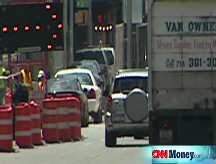The $8 trillion bailout
Many details of Obama's rescue plan remain uncertain. But it's likely to cost at least $700 billion - and that would push Uncle Sam's bailouts near $8 trillion.
NEW YORK (CNNMoney.com) -- Sitting down? It's time to tally up the federal government's bailout tab.
There was $29 billion for Bear Stearns, $345 billion for Citigroup. The Federal Reserve put up $600 billion to guarantee money market deposits and has aggressively driven down interest rates to essentially zero.
The list goes on and on. All told, Congress, the Treasury Department, the Federal Reserve and other agencies have taken dozens of steps to prop up the economy.
Total price tag so far: $7.2 trillion in investment and loans. That puts a lot of taxpayer money at risk. Now comes President-elect Barack Obama's economic stimulus plan, some details of which were made public on Monday. The tally is getting awfully close to $8 trillion.
Obama's plan would combine tax cuts with infrastructure job creation efforts. Economists say it could serve as an integral piece to the government's remaining economic recovery puzzle.
"This plan will be the first direct tool to make additions to disposable income," said Lyle Gramley, an economist with Stanford Group and former Fed governor. "None of the other efforts have done that directly."
Gramley said that a stimulus program from the government is a necessary complement to the Fed's traditional rate-cutting tool. Together with existing actions, stimulus can provide a wider reach to the government's economic intervention.
"Monetary stimulus alone is not enough - it must be combined with fiscal stimulus if you want more bang for your buck," he noted.
But the new program, which Obama aides have said could total $775 billion, will also weigh heavily on the ballooning federal deficit. The current fiscal year is barely a few months old and already the government is running a deficit exceeding $400 billion -- nearly the same amount as all of last year. Many economists believe it will top $1 trillion, not even counting stimulus.
Some say that the benefits of massive spending outweigh the cost of inaction.
"While it seems like quite a lot, we don't really need to focus on the cost due to the depth of the recession," said Mark Vitner, economist with Wachovia.
Others, while saying that government action is needed, question the vast sums that are being allocated and proposed.
"The government says it can spend the money better than you can, but that hasn't been the case in the past," said Bill Beach, director of the center for data analysis at the conservative-leaning Heritage Foundation. "That will really show up when they have to raise taxes in the future to make up for the increasing deficit."
So where does Obama's plan fit in with Uncle Sam's unprecedented onslaught of efforts to stabilize the economy?
The story begins more than a year ago with the Federal Reserve.
In September 2007, with the housing market in its early decline and credit markets showing signs of trouble, the Fed began to lower its key fund rates from 5.25% in an attempt to boost economic activity and ward off a recession.
The economy nevertheless entered a recession in December 2007. Though the Fed rate is now at a targeted level of close to 0%, economists have noticed little change by way of increased availability of credit, lower private interest rates or a booming stock market.
"None of those things have happened," said Gramley. "Fed policy has not had any kind of impact like it normally has, even as the Fed lowered the funds rate a long way."
Concerned about the threat of a recession, lawmakers passed $168 billion in tax breaks to consumers and businesses in February of last year. The aim: boost spending, which accounts for more than two-thirds of the nation's gross domestic product.
The rebates had a short-lived impact, helping to boost GDP 2.8% in the second quarter of 2008, compared to a measly 0.9% in the first quarter. But last summer's rapidly rising fuel prices undid the spending trend, sending GDP down 0.5% in the third quarter.
The credit crisis that began in mid-September unwound any hopes of staving off a recession. The government's focus instead became a massive effort to keep systemically significant institutions from collapsing.
After Bear Stearns' $29 billion bailout in March, and the $200 billion government takeover of mortgage finance giants Fannie Mae (FNM, Fortune 500) and Freddie Mac (FRE, Fortune 500) in early September, the Treasury and Fed shifted bailout efforts into top gear after Sep. 15. They bailed out AIG for $152.5 billion, Citigroup for $325 billion and the automakers for $23.4 billion in just the past few months.
Treasury also took hold of the $700 billion Emergency Economic Stabilization Act, dedicating $250 billion to capital investments in banks.
In a status report delivered last week, Treasury said its efforts have prevented widespread failure of financial institutions, but they conceded that the credit crisis won't ease until the economy recovers.
"The financial system is fundamentally more stable than it was when Congress passed the legislation," said the report. "As long as confidence remains low, banks will remain cautious about extending credit, and consumers and businesses will remain cautious about taking on new loans."
To help the economy heal, the government has committed record sums since September 2008 in an attempt to restore the flow of credit, boost the job and housing markets and - with Obama's plan - get consumers spending again.
In the past three months, the Federal Reserve launched a $600 billion money market guarantee program, a $1.4 trillion program to boost the commercial paper market - a key source of short-term business financing, a $200 billion consumer loan-backed securities purchasing program, a $500 billion mortgage-backed securities purchasing program and a $100 billion program to buy up Fannie and Freddie debt.
As a result, the Fed's balance sheet - the total worth of the assets the Fed obtained as a result of its lending - currently totals $2.3 trillion, up from $933 billion on the week before Lehman Brothers collapsed.
Obama's estimated $775 billion plan could serve as the next step in the recovery efforts. While most of the Fed's programs have been aimed at boosting lending, Obama's economic stimulus plan is aimed primarily at job creation and consumer spending. ![]()




